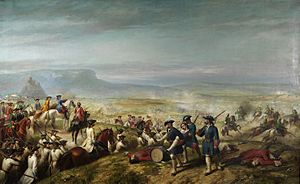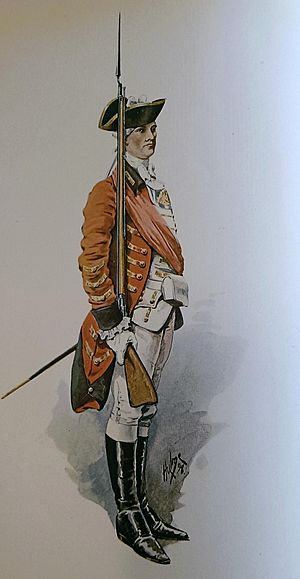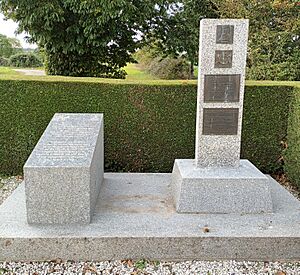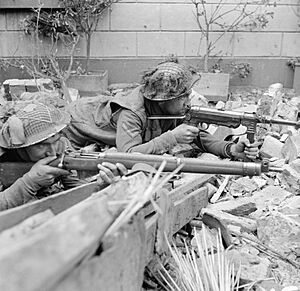Royal Norfolk Regiment facts for kids
Quick facts for kids Norfolk RegimentRoyal Norfolk Regiment |
|
|---|---|

Cap badge of the Royal Norfolk Regiment.
|
|
| Active | 1685–1959 |
| Country | |
| Branch | |
| Type | Infantry |
| Role | Line infantry |
| Size | 2 Regular battalions 1–2 Militia and Special Reserve battalions |
| Garrison/HQ | Gorleston Barracks, Great Yarmouth (1881–1887) Britannia Barracks, Norwich (1887–1959) |
| Nickname(s) | "The Holy Boys" "The Fighting Ninth" "The Norfolk Howards" |
| Motto(s) | Firm |
| Facings | Yellow |
| March | Rule Britannia |
| Anniversaries | Almanza, 25 April |
| Battle honours | see below |
| Insignia | |
| Shoulder titles | "Royal Norfolk" |
The Royal Norfolk Regiment was a famous infantry regiment in the British Army. It existed until 1959. This regiment started way back in 1685. It was first known as Henry Cornwall's Regiment of Foot. Later, in 1751, it became the 9th Regiment of Foot. This was when most British Army regiments got numbers.
In 1881, it officially became the Norfolk Regiment. This happened when the 9th Regiment joined with local Militia and Rifle Volunteers groups. This change was part of big army reforms. The regiment was linked to the county of Norfolk in England.
The Norfolk Regiment fought bravely in the First World War. They served on the Western Front and in the Middle East. After the war, in 1935, it was renamed the Royal Norfolk Regiment. They also fought with great courage in the Second World War. They saw action in France, Belgium, the Far East, and later in North-west Europe.
In 1959, the Royal Norfolk Regiment joined with the Suffolk Regiment. They formed a new group called the 1st East Anglian Regiment (Royal Norfolk and Suffolk). This new regiment later combined with others to create the Royal Anglian Regiment. Today, A Company of the 1st Battalion of the Royal Anglian Regiment is still known as the Royal Norfolks.
Contents
- A Look Back: The Regiment's Story
- Regimental Museum: A Place to Learn
- Regimental Chapel
- Uniform and Special Symbols
- Regimental Traditions
- Battle Honours: Marks of Bravery
- Victoria Cross Heroes
- See also
A Look Back: The Regiment's Story
Starting Out: Early Years
The regiment began in Gloucester in 1685. Colonel Henry Cornewall formed it for the English Army. This was to help King James II during the Monmouth Rebellion. The regiment saw early action in the Williamite War in Ireland. They helped relieve the besieged city of Derry in 1689. They also fought in important battles like the Battle of the Boyne in 1690.
In 1701, the regiment went to Holland. They fought in the War of the Spanish Succession. Later, in 1704, they went to Lisbon. They took part in the Battle of Almansa in April 1707. In 1751, the regiment was officially named the 9th Regiment of Foot. This was when all British regiments received numbers. During the Seven Years' War, they captured Belle Île from the French in 1761. They also helped capture Havana in Cuba in 1762.
After the war, the regiment moved to St. Augustine, Florida. They stayed there until 1769. In 1776, they went to Canada. They fought in the American Revolutionary War. They were part of the Battles of Saratoga in 1777. After this, many soldiers became prisoners of war.
In 1782, the regiment became the 9th (East Norfolk) Regiment of Foot. This was to help with army recruitment. They served in the West Indies in 1788. They captured Tobago and Saint Lucia. In 1799, King George III approved Britannia as their symbol. They also fought in the Anglo-Russian invasion of Holland in 1799.
Fighting in the Napoleonic Wars
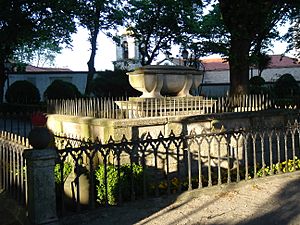
In 1808, the regiment went to Portugal. They fought in the Peninsular War. They saw action at the Battle of Roliça and the Battle of Vimeiro. After the retreat from Corunna, they buried their commander, Sir John Moore.
The regiment returned to the Peninsula in 1810. They fought under Wellington. They were at the Battle of Bussaco in 1810. They also fought at the Battle of Salamanca in 1812. They helped capture Ciudad Rodrigo and Badajoz. They pursued the French Army into France. They fought at the Battle of Nivelle and the Battle of the Nive in 1813.
The regiment was then sent to Canada. This was to stop an invasion by the United States. Because of this, they missed the famous Battle of Waterloo.
The Victorian Era: Global Service
The regiment served in Kabul in 1842. This was during the First Anglo-Afghan War. They also fought in the First Anglo-Sikh War in India. They were at the Battle of Mudki and the Battle of Sobraon.

They fought in the Crimean War at the siege of Sevastopol in 1854. In 1866, they were stationed in Yokohama, Japan. They protected British interests there. They saw action in Kabul again in 1879. This was during the Second Anglo-Afghan War.
In 1881, the regiment officially became The Norfolk Regiment. It had two regular battalions and two militia battalions. It kept all the battle honours and traditions.
In 1899, the Second Boer War began in South Africa. The 2nd Battalion went to fight there in 1900. They saw action at the Battle of Poplar Grove. The war ended in 1902.
In 1908, the army was reorganised. The regiment now had one Reserve and three Territorial battalions.
The First World War (1914-1918)
Regular Army Battalions
The 1st Battalion was in Ireland when the war started in 1914. They quickly went to France. They were part of the British Expeditionary Force (BEF). They fought their first battle at Mons in August 1914. The 2nd Battalion was in India. They later fought in the Mesopotamian campaign. They were involved in the fall of Kut al Amara in 1916.
Territorial Force Battalions
The 4th and 5th Territorial Force battalions served in the Gallipoli campaign in 1915. The 1/5th Battalion included men from the Royal estate at Sandringham.
On 12 August 1915, the 1/5th Battalion faced heavy losses at Gallipoli. They became separated during an attack. A story grew that they marched into a mist and vanished. A TV drama, All the King's Men, was based on their story.
In the Second Battle of Gaza in 1917, the 1/4th and 1/5th battalions suffered many casualties. The Norfolk Yeomanry also fought in Gallipoli. They later became the 12th (Norfolk Yeomanry) Battalion. This battalion fought in the Palestine Campaign. They were at the Third Battle of Gaza in 1917.
Service Battalions
The 7th (Service) Battalion was formed in 1914. It landed in France in 1915. It served on the Western Front. The 8th (Service) Battalion also landed in France in 1915. It was present on the first day of the Battle of the Somme in 1916. The 9th (Service) Battalion also fought on the Western Front.
Victoria Cross Hero
During the war, Lieutenant Colonel Jack Sherwood Kelly was awarded the Victoria Cross. This is the highest award for bravery. He received it for leading an attack during the Battle of Cambrai in 1917.
The Second World War (1939-1945)

The regiment was renamed the Royal Norfolk Regiment in 1935. This celebrated its 250th anniversary. In 1940, soldiers from the 2nd Battalion received the first bravery awards in France. Captain Frank Peter Barclay won the Military Cross.
Five members of the Royal Norfolks won the Victoria Cross during this war. This was the highest number for any British Army regiment. These heroes were:
- David Auldjo Jamieson
- John Niel Randle
- George Gristock
- Sidney Bates
- George Arthur Knowland
Regular Army Battalions in Action
The 1st Battalion was in India when the war started. They returned to Britain in 1940. They landed on Sword Beach on D-Day, 6 June 1944. They fought bravely through the Normandy Campaign. They continued fighting in North-west Europe. Sidney Bates of B Company won a Victoria Cross in France in 1944. By the end of the war, the 1st Battalion had an amazing reputation. Field Marshal Sir Bernard Montgomery called them 'second to none'.
In 1940, during the Battle of France, Company Sergeant-Major George Gristock of the 2nd Royal Norfolks won a Victoria Cross. During this battle, a tragic event happened to some Royal Norfolks soldiers. After surrendering, many were killed by German forces at Le Paradis. Two soldiers survived by hiding. The person responsible was later found guilty and punished.
The 2nd Battalion also served in the Burma campaign in the Far East. They fought in battles like Battle of Kohima. This army was known as the 'Forgotten Army'. John Niel Randle and George Arthur Knowland both won Victoria Crosses in the Far East.
Territorial Army Battalions
The 4th, 5th, and 6th Territorial Army battalions served in the Far East. They defended Singapore and Malaya against the Japanese. Many of these soldiers became prisoners of war when Singapore fell in 1942. They were forced to work on projects like the Death Railway in Burma.
The 7th Battalion was formed in 1939. It served in France with the British Expeditionary Force. This battalion suffered many losses in 1940. Only 31 members managed to return to Britain. Later, in 1944, Captain David Auldjo Jamieson of D Company won a Victoria Cross in France. This was for his brave leadership against enemy attacks.

Home Front and Support Battalions
The 8th and 9th Battalions were mainly used to provide new soldiers for those fighting overseas. They stayed in the United Kingdom. The 70th (Young Soldiers) Battalion was for young volunteers. It was disbanded in 1943. Its young soldiers were sent to other battalions fighting abroad.
After the Second World War
The regiment served in Korea from 1951–52 during the Korean War. They also served in Cyprus in 1955–56. In 1959, the Royal Norfolk Regiment joined with other regiments. They became part of the new 1st East Anglian Regiment.
Regimental Museum: A Place to Learn
The Royal Norfolk Regimental Museum tells the story of the regiment. It shows its history from the 1600s to today. The museum is now located at the Norwich Castle Museum. You can see uniforms, weapons, and medals there. It includes two of the six Victoria Crosses won by the regiment.
Regimental Chapel
St Saviour's Chapel in Norwich Cathedral is the regiment's chapel. It has memorials to the 9th Foot/Royal Norfolk Regiment. It also remembers those who fought in the Korean War.
Uniform and Special Symbols
The regiment's uniform changed over time. In the early days, they wore orange and green colours. By 1747, this changed to yellow. Yellow became their special colour. In 1881, they wore white. But in 1905, the yellow colours were brought back. When they became the "Royal Norfolk Regiment" in 1935, they kept their yellow colours.
The figure of Britannia became a key symbol in 1799. It was part of the 9th Regiment of Foot's badge. A tradition says Queen Anne gave it to them in 1707. This was for their service at the Battle of Almanza.
Regimental Traditions
The Royal Norfolk Regiment celebrated the Battle of Almansa every year on April 25. They also had a special nickname: the "Holy Boys". They got this name during the Peninsular War. A Spanish soldier mistook the figure of Britannia on their cap badge for the Virgin Mary.
Battle Honours: Marks of Bravery
Battle honours are special awards given to military units. They celebrate brave actions in battles. The Royal Norfolk Regiment earned many battle honours throughout its history. Here are some of the most important ones:
- Earlier Years: Belleisle, Havannah, Martinique 1794, Roliça, Vimiera, Corunna, Busaco, Salamanca, Vitoria, San Sebastián, Nive, Peninsula, Cabool 1842, Moodkee, Ferozeshah, Sobraon, Sevastopol, Kabul 1879, Afghanistan 1879–80, Paardeberg, South Africa (1900–02).
- First World War: Mons, Le Cateau, Marne 1914, Ypres 1914, Somme 1916, Hindenburg Line, Landing at Suvla, Gaza, Shaiba, Kut al Amara 1915.
- Second World War: St Omer-La Bassée, North-West Europe 1940, Normandy Landing, Brieux Bridgehead, Venray, Rhineland, North-West Europe 1944–45, Singapore Island, Kohima, Aradura (1944–1945), Burma 1944–45.
- Later Wars: Korea 1951–52.
Victoria Cross Heroes
The Victoria Cross (VC) is the highest award for bravery in the British armed forces. Six members of the Norfolk or Royal Norfolk Regiment earned this incredible honour:
- Acting Lieutenant-Colonel John Sherwood-Kelly – for bravery during the Battle of Cambrai.
- Company Sergeant Major George Gristock – in Belgium during the Battle of France.
- Captain John Niel Randle – in the Far East in 1944.
- Corporal Sidney Bates – 1st Battalion, France 1944.
- Captain David Jamieson – in France at the Brieux bridgehead, 1944.
- Lieutenant George Arthur Knowland – attached to No. 1 Commando, Burma 1945.
See also
- List of British Army regiments (1881)
- 54th (West Norfolk) Regiment of Foot (1782–1881)
- Norfolk Yeomanry
- West Runton War Memorial
- Sheringham War Memorial


